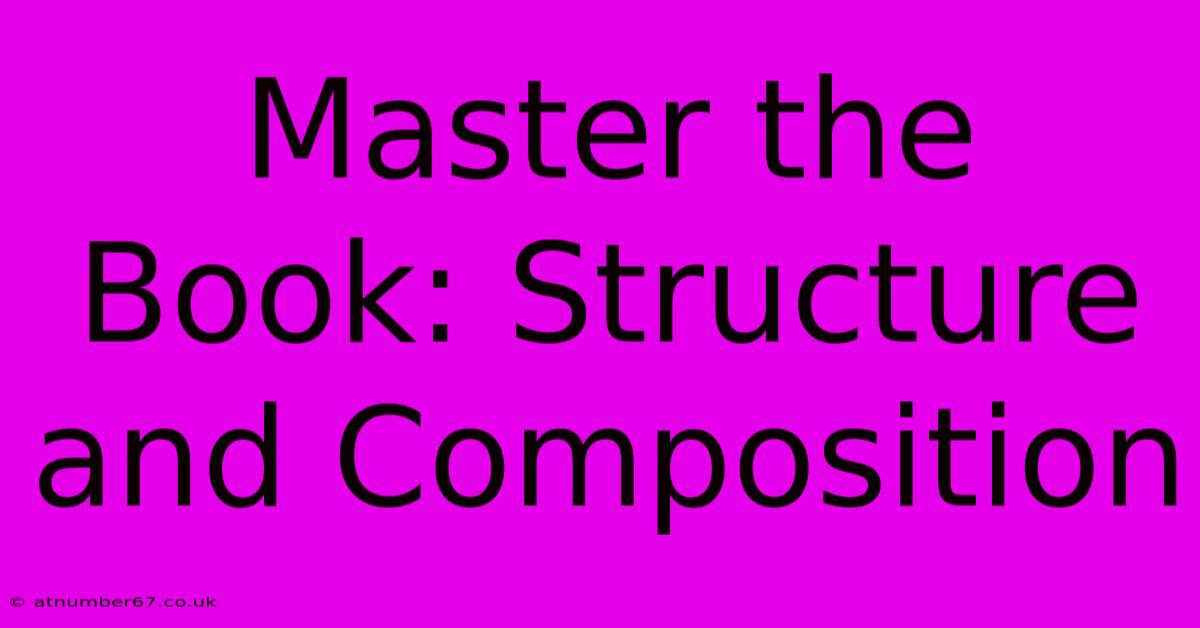Master The Book: Structure And Composition

Table of Contents
Master the Book: Structure and Composition
Writing a book is a marathon, not a sprint. While inspiration is crucial, the true key to crafting a compelling and successful narrative lies in mastering the book's structure and composition. This isn't just about plot; it's about crafting a reading experience that captivates your audience from the first page to the last. This article will delve into the essential elements of book structure and composition, offering practical tips to help you build a compelling and unforgettable story.
Understanding Book Structure: The Blueprint of Your Narrative
Before you even think about writing a single word, you need a solid blueprint. This blueprint is your book's structure, the underlying framework that supports your narrative. Several common structures exist, and choosing the right one depends heavily on your genre and story:
1. Linear Structure: The Classic Approach
This is the most traditional structure, presenting events chronologically. It's straightforward and easy to follow, making it ideal for many genres, including romance, thrillers, and even some non-fiction. However, it can become predictable if not handled with care.
2. Non-Linear Structure: Jumbling Time for Impact
Non-linear structures jump between timelines, often using flashbacks or flash-forwards. This can create suspense, reveal character motivations gradually, or offer multiple perspectives on the same event. It's commonly used in literary fiction, mysteries, and historical novels. Mastering this requires careful planning to avoid confusing the reader.
3. In Media Res: Throwing the Reader into the Action
Starting in media res – Latin for "in the midst of things" – plunges the reader directly into the action, often at a crucial point in the story. This technique immediately grabs the reader's attention but requires skillful execution to avoid leaving them disoriented.
4. Epistolary Structure: Through Letters and Documents
This structure uses letters, diary entries, or other documents to tell the story. It offers a unique intimacy and can create a sense of immediacy. However, it requires careful management to maintain reader engagement and avoid monotony.
The Art of Composition: Weaving Words into a Tapestry
Book structure provides the skeleton; composition is the flesh and blood that bring it to life. Effective composition involves several key elements:
1. Pacing: Controlling the Rhythm of Your Story
Pacing refers to the speed at which the story unfolds. Varying your pacing is crucial to maintain reader interest. Fast-paced sections create excitement, while slower sections allow for character development and reflection.
2. Character Development: Creating Believable People
Readers need to connect with your characters. Develop them through their actions, dialogue, thoughts, and interactions with other characters. Show, don't tell, is a fundamental principle here.
3. Plot Development: Building Tension and Resolution
Your plot should have a clear beginning, middle, and end, with rising action, climax, and falling action. Introduce conflict early and gradually raise the stakes to keep readers invested.
4. Setting: Creating a Vivid and Immersive World
Your setting is more than just a backdrop; it's a character in itself. Use descriptive language to bring your setting to life, creating a sense of place that enhances the overall reading experience.
5. Theme: Exploring Underlying Meanings
A strong theme provides depth and resonance to your story. It's the underlying message or idea you want to convey. Consider what you want your readers to take away from your book.
6. Point of View: Choosing the Right Perspective
The point of view dictates how the story is told. First-person offers intimacy, third-person omniscient provides broad scope, and limited third-person focuses on a single character's perspective. Choosing the right POV is crucial for tone and reader engagement.
Mastering the Craft: Tips for Success
- Outline your story: Even if you're a pantser (a writer who writes by the seat of their pants), a basic outline can prevent plot holes and ensure a cohesive narrative.
- Seek feedback: Share your work with beta readers for constructive criticism.
- Revise and edit ruthlessly: Polishing your manuscript is as important as writing it.
- Learn from the masters: Read widely in your genre to study different structural approaches and compositional techniques.
By understanding and mastering the principles of book structure and composition, you can transform your ideas into compelling narratives that resonate with readers. Remember, it's a journey, and continuous learning and refinement are key to creating a masterpiece.

Thank you for visiting our website wich cover about Master The Book: Structure And Composition. We hope the information provided has been useful to you. Feel free to contact us if you have any questions or need further assistance. See you next time and dont miss to bookmark.
Featured Posts
-
Cruz Beckhams Age A Family Affair
Apr 03, 2025
-
Wizkid Age A Look Back At His Journey
Apr 03, 2025
-
Damian Hurleys Rise To Fame Elizabeth Hurleys Influence
Apr 03, 2025
-
Suzy Sheeps Dad A Story Of Loss And Hope
Apr 03, 2025
-
Discover Jan Stenbecks Massive Net Worth
Apr 03, 2025
